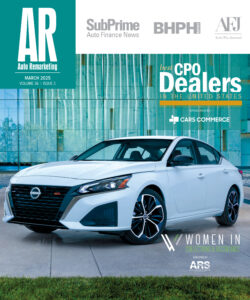Are CUVs a Wise Choice for Used Inventory?

Did wholesale prices for crossovers reach a tipping point in September? Analysts from Kelley Blue Book believe they might have found the answer.
KBB calculated overall wholesale market prices slid 1.5 percent in September as compared to the previous month. Just two of its 21 vehicle segments moved marginally higher — midsize pickups by 0.8 percent and vans by 0.5 percent.
Fueling the overall decline in KBB’s analysis were crossovers. Midsize CUVs dipped 3.3 percent, and full-size CUVs slipped 3.7 percent.
KBB’s Juan Flores, director of vehicle valuation, and Alec Gutierrez, lead analyst of vehicle valuation, believe this trend associated with CUVs might not go away.
“As manufacturers continue to add more vehicles to the crossover segment, the potential for future weakness increases,” Flores and Gutierrez explained. “The most hard-hitting drops come from vehicles that are a bit ‘long in tooth.’”
The pair cited three examples. They said the Lincoln MKX, which is set for a refresh for the 2011 model, is down 8.5 percent. The vehicle is closely followed by Mazda’s CX-7, which fell 7.8 percent despite being slightly updated for the 2010 model year. Also of note was another domestic model no longer in production, Buick’s Rendezvous, which Flores and Gutierrez indicated is off by 5.4 percent.
Are CUVs a Good Inventory Option?
During the past four years, consumers have been flocking to CUVs. KBB put some concrete figures behind this movement that dealers certainly know well.
KBB data revealed crossovers constituted 13 percent of new-vehicle sales in 2006. This year, CUV sales have ballooned to 22 percent.
During that span, sales of cars, SUVs, trucks and vans all dropped. KBB pinpointed the car penetration moving from 52 percent to 49 percent with SUV sales slipping from 13 percent to 7 percent. Truck sales have slid from 17 percent to 13 percent, and van sales have edged down from 8 percent to 6 percent.
So what do those sale numbers mean to used-car managers?
“There has been strong support for crossover leasing by OEMs, which is a reflection of the shift in consumer demand toward these vehicles. Crossovers are increasingly prevalent in the marketplace. As a result, availability of used crossovers during the next several years will be high,” Flores and Gutierrez explained.
“Competition will be high in the crossover segment as more manufacturers convert existing truck-based SUVs to unibody crossovers,” they added.
Two models KBB mentioned to illustrate this point are the Ford Explorer and Dodge Durango
“The truck-based SUV will continue to decline in popularity as fuel economy and handling remain top priorities for consumers. Dealers would be wise to keep inventories of used crossovers up,” Flores and Gutierrez advised.
“Leasing patterns since 2008 are a prime example of the industry’s move away from truck-based SUVs and trucks toward unibody crossovers,” they insisted.
“While leasing activity for trucks and SUVs dropped aggressively and has remained low following the onset of the recession in 2008, leasing activity for crossovers has been on the rebound after leveling off in early 2009,” Flores and Gutierrez said. “Moving forward, Kelley Blue Book expects continued lease support for crossovers while lease deals for trucks and SUVs will remain few and far between.”
More Month-Over-Month Analysis
Beyond the extensive CUV dialogue, KBB also pointed out hybrid cars dropped 2.3 percent in September, one of six segments with declines of at least 2 percent.
“It is business as usual with gas prices, unemployment rates and credit availability, all of which have been fairly consistent during the past several months,” Flores and Gutierrez shared.
“September showed that nearly every segment has softened, even given current stable market conditions,” they continued. “These drops are mostly seasonal with increased auction volumes influencing some of the more significant drops.
“Current demand has been unable to offset the increased auction volumes that have resulted as vehicles leased in 2006 and 2007 return to the market. This primarily affects luxury vehicles since these vehicles are predominantly sold through leasing programs,” Flores and Gutierrez added.
Year-To-Date Prices Changes
So which segments have not enjoyed positive price movement in 2010?
“Luxury and hybrid vehicles have not fared well this year,” they indicated. “On a year-to-date basis, hybrid and luxury segments have underperformed the market by a considerable margin. While values for these segments are up 2.75 percent from this time last year, we are seeing significant year-to-date declines.”
To further the point, KBB revealed luxury crossovers have plunged 8.1 percent, followed by hybrid crossovers (down 7.9 percent), hybrid cars (down 6.0 percent) and luxury cars (down 4.0 percent).
“In a soft economy, the premium for these vehicles is difficult to justify as consumers seek ways to cut back financially,” Flores and Gutierrez surmised.
“Additionally, gas prices do not support a consumer’s need for a hybrid at current levels. An unusually swelled supply of luxury vehicles due to aggressive leasing back in 2006 and 2007 also has contributed to their depreciation,” the went on to say.
Heading in the opposite direction, according to KBB, are trucks, minivans and full-size SUVs.
Flores and Gutierrez contend full-size trucks are up 16.5 percent, followed by minivans at 7.3 percent, full-size SUVs up 6.8 percent and mid-size trucks at 6.5 percent.
“These segments are still recovering from an extremely soft 2009 market,” they conceded.
“Low inventories also are keeping values strong due to a lack of new sales and leases,” Flores and Gutierrez further mentioned. “Minimal leasing of trucks and SUVs also could indicate that low inventories of these vehicles will remain a concern for years to come, making these vehicles best bets for dealers.”
Used-Vehicle Shopper Activity at Kbb.com
Potential buyers in California evidently are attracted to the 2009 BMW 5 Series.
As a part of the October report, KBB also shared its Top 10 models that enjoyed the greatest increases and decreases in shopper activity month-over-month. The leader was that BMW unit, whose activity jumped by 46.9 percent.
Site analysis drilled down into the data a little further and found where most of that traffic derived. Turns out, 17.4 percent of share for the 2009 BMW 5 Series in September came from California.
The rest of the vehicles enjoying the most shopper activity growth showed at least an increase of 24 percent. Those units include:
—2007 Honda Element: up 35.5 percent.
—2007 Porsche 911: up 34.4 percent.
—2006 BMW X3: up 29.7 percent.
—2008 Volkswagen New Beetle: up 27.8 percent.
—2008 Chevrolet Avalanche: up 27.4 percent.
—2005 Chevrolet Silverado 2500 HD: up 25.9 percent.
—2008 Land Rover Range Rover Sport: up 25.6 percent.
—2007 Kia Sportage: up 24.5 percent.
—2009 Dodge Challenger: up 24.5 percent.
Going in the opposite direction were 10 models with shopping activity decreases of at least 19 percent. Leading the way was the 2006 Toyota Matrix at a decline 30.3 percent. Not far behind was the 2007 Acura TSX with a drop of 27.9 percent.
The rest of the models with the greatest decrease in September included:
—2009 Hyundai Elantra: down 24.2 percent.
—2006 Infiniti M: down 24.1 percent.
—2008 Mercury Milan: down 23.5 percent.
—2009 Kia Sedona: down 22.5 percent.
—2007 Acura TL: down 22.0 percent.
—2008 Suzuki SX4: down 20.9 percent.
—2007 Toyota Matrix: down 20.5 percent.
—2007 Hyundai Accent: down 19.6 percent.
Turning over to September shopping activity readings by vehicle segment, Kbb.com discovered sports cars and luxury SUVs had nearly identical gains at 5.4 percent and 5.1 percent, respectively.
The site also found all types of hybrids suffered declines in September with the hybrid pickup segment with experiencing the greatest decline in share, down 28 percent month-over-month.
“This isn’t abnormal given that the used hybrid market is still small and subject to volatility due to limited inventories,” Flores and Gutierrez deduced. “Kelley Blue Book recommends that dealerships focus on sports cars and luxury vehicles as interest rises.”
Consumer Belt Tightening Hurts Some Luxury Brands
Wrapping up the October Market Report, Flores and Gutierrez revealed that several luxury brands are underperforming on a year-to-date basis. That group includes Mercedes-Benz, Acura, Land Rover and Lexus
“Luxury brands are not performing well in the used-car marketplace,” Flores and Gutierrez insisted. “The demand for these vehicles today is not sufficient enough to absorb the significant lease volumes coming back into the marketplace.”
To back up their claims, Flores and Gutierrez cited more specific models. They noted the Mercedes-Benz R-Class is down 21 percent year-to-date, followed by the Acura MDX and Lexus GS, which are both off by 13 percent. They added the Range Rover has dropped 11 percent year-to-date.
“Luxury vehicles could remain soft through the rest of the year and into 2011, until leases returning to auction more closely match with current demand,” Flores and Gutierrez predicted.
“Most leases are returning for 2- to 3-year-old vehicles, so we currently are seeing leases from 2006 to 2008 model-years hitting the marketplace,” they went on to say. “If current demand remains consistent, it could be well into 2011 before lease returns match up with current market demand.”

 View The Latest Edition
View The Latest Edition

